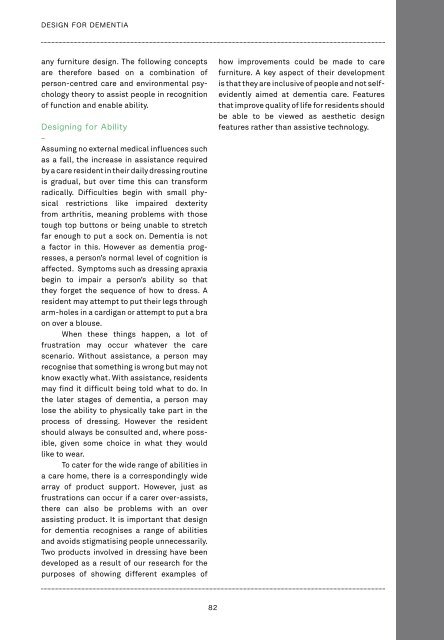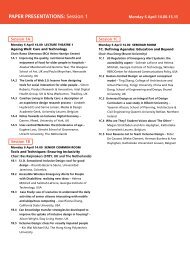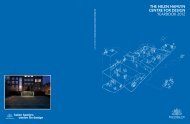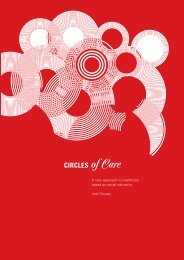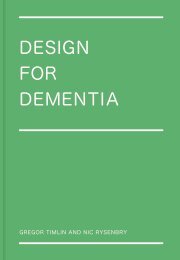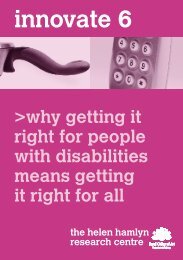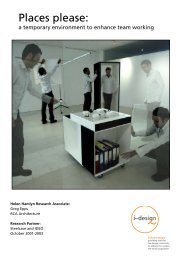Design for Dementia - Helen Hamlyn Centre - Royal College of Art
Design for Dementia - Helen Hamlyn Centre - Royal College of Art
Design for Dementia - Helen Hamlyn Centre - Royal College of Art
Create successful ePaper yourself
Turn your PDF publications into a flip-book with our unique Google optimized e-Paper software.
DESIGN FOR DEMENTIA<br />
BEDROOM<br />
any furniture design. The following concepts<br />
are there<strong>for</strong>e based on a combination <strong>of</strong><br />
person-centred care and environmental psychology<br />
theory to assist people in recognition<br />
<strong>of</strong> function and enable ability.<br />
<strong>Design</strong>ing <strong>for</strong> Ability<br />
–<br />
Assuming no external medical influences such<br />
as a fall, the increase in assistance required<br />
by a care resident in their daily dressing routine<br />
is gradual, but over time this can trans<strong>for</strong>m<br />
radically. Difficulties begin with small physical<br />
restrictions like impaired dexterity<br />
from arthritis, meaning problems with those<br />
tough top buttons or being unable to stretch<br />
far enough to put a sock on. <strong>Dementia</strong> is not<br />
a factor in this. However as dementia progresses,<br />
a person’s normal level <strong>of</strong> cognition is<br />
affected. Symptoms such as dressing apraxia<br />
begin to impair a person’s ability so that<br />
they <strong>for</strong>get the sequence <strong>of</strong> how to dress. A<br />
resident may attempt to put their legs through<br />
arm-holes in a cardigan or attempt to put a bra<br />
on over a blouse.<br />
When these things happen, a lot <strong>of</strong><br />
frustration may occur whatever the care<br />
scenario. Without assistance, a person may<br />
recognise that something is wrong but may not<br />
know exactly what. With assistance, residents<br />
may find it difficult being told what to do. In<br />
the later stages <strong>of</strong> dementia, a person may<br />
lose the ability to physically take part in the<br />
process <strong>of</strong> dressing. However the resident<br />
should always be consulted and, where possible,<br />
given some choice in what they would<br />
like to wear.<br />
To cater <strong>for</strong> the wide range <strong>of</strong> abilities in<br />
a care home, there is a correspondingly wide<br />
array <strong>of</strong> product support. However, just as<br />
frustrations can occur if a carer over-assists,<br />
there can also be problems with an over<br />
assisting product. It is important that design<br />
<strong>for</strong> dementia recognises a range <strong>of</strong> abilities<br />
and avoids stigmatising people unnecessarily.<br />
Two products involved in dressing have been<br />
developed as a result <strong>of</strong> our research <strong>for</strong> the<br />
purposes <strong>of</strong> showing different examples <strong>of</strong><br />
how improvements could be made to care<br />
furniture. A key aspect <strong>of</strong> their development<br />
is that they are inclusive <strong>of</strong> people and not selfevidently<br />
aimed at dementia care. Features<br />
that improve quality <strong>of</strong> life <strong>for</strong> residents should<br />
be able to be viewed as aesthetic design<br />
features rather than assistive technology.<br />
WARDROBE<br />
The wardrobe is the hub <strong>for</strong> dressing and<br />
should provide care and support <strong>for</strong> longevity<br />
<strong>of</strong> use at every stage <strong>of</strong> dementia.<br />
1.<br />
2.<br />
3.<br />
Height Reduction and Access<br />
According to research by Renray Healthcare,<br />
the average height <strong>of</strong> a person in care<br />
is 5 ft 3 ins. This makes traditional wardrobe<br />
heights inaccessible, a state <strong>of</strong> affairs compounded<br />
by age-related stiffness and other<br />
physical ailments. A significant proportion<br />
<strong>of</strong> residents will also be in a wheelchair at<br />
some point. Full-height wardrobes contain<br />
many inaccessible features based purely<br />
on the height. Lower areas can be just as<br />
inaccessible <strong>for</strong> older people. The wardrobe<br />
has been split into daily use (the doors) and<br />
seasonal use (the bottom drawers). The<br />
latter is explained further below.<br />
Colour and Material<br />
A combination <strong>of</strong> two contrasting materials<br />
helps those with sight problems to understand<br />
where to interact with the product.<br />
Use <strong>of</strong> good quality hardwood laminates<br />
creates variations in surface texture; they<br />
are also hygienic, easy to maintain.<br />
Oversized Handles<br />
The oversized handle is a good example<br />
<strong>of</strong> the chosen aesthetic, its size and prominence<br />
suggesting its function. Heavily<br />
contrasted against the white background,<br />
the handle is easily visible <strong>for</strong> those with<br />
sight loss. Reaching from top to bottom<br />
allows both taller residents and those<br />
in wheelchairs the same access point.<br />
As the one main point <strong>of</strong> interaction, the<br />
handle is made <strong>of</strong> hardwood to achieve a<br />
quality feel.<br />
4.<br />
5.<br />
6.<br />
Content Visible Drawers<br />
Signs on drawers are evident in current<br />
homes and <strong>of</strong>fer many benefits, even though<br />
residents, family members and carers<br />
suggested that this approach might be stigmatising.<br />
A new drawer front, which shows<br />
the drawer’s contents whilst remaining<br />
as similar to a standard drawer design as<br />
possible, gives the person cues to the<br />
whereabouts <strong>of</strong> specific items <strong>of</strong> clothing<br />
while making the signage redundant.<br />
Personalisation<br />
Personalisation should exist in as many<br />
places as possible to give com<strong>for</strong>t, enable<br />
communication and assist in identifying<br />
ownership. Having pictures <strong>of</strong> loved ones,<br />
hobbies and other topics relating to a<br />
person’s personal history placed on the<br />
wardrobe will help residents recognise that<br />
the possessions they are interacting with<br />
are their own.<br />
Out-<strong>of</strong>-season storage<br />
It is important not to confuse residents with<br />
too many clothing choices. In this wardrobe,<br />
summer and winter clothing areas have<br />
been separated to reduce choice. Out-<strong>of</strong>season<br />
clothes are able to be stored on site<br />
by designing the drawers to be naturally<br />
inaccessible <strong>for</strong> residents. Placing the<br />
drawers low, to the back and with no<br />
environmental cues as to operation, limits<br />
access without the need <strong>for</strong> a lock or to<br />
store them in an <strong>of</strong>fsite location.<br />
82<br />
83


